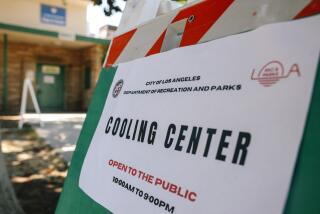May warmth helps shatter spring temperature records
May was so warm that it helped shatter weather records for the Lower 48 states -- records that go back to 1895.
According to data released Thursday by the National Oceanic and Atmospheric Administration, U.S. temperatures have been high enough to make it the warmest spring on record, the warmest year-to-date and the warmest 12-month period as well.
“This warmth is an example of what we would expect to see more often in a warming world. Understanding that the United States and the rest of the planet are warming along with preparing for eventualities like this is one way our nation can become climate-smart,” Deke Arndt, chief of the climate monitoring branch, National Climatic Data Center, says in the video above.
The changes were so large that the impact goes beyond just the usual griping and carping about the weather.
How meteorological cycles work play significant roles in the macro-economic world -- in agriculture, in energy consumption and even in employers’ decisions on whether to hire more workers.
For example, the warmer period has caused dislocation in the fruit-growing season in the East. Some economists suggest that the milder winter allowed employers to hire workers sooner, making recent spring unemployment numbers look soft. And that, of course, has the potential to influence elections.
According to the center’s data, the average temperature in the contiguous United States was 64.3 degrees Fahrenheit, the second-warmest May on record. Meteorologists see spring as the three-month period beginning in March and running to the end of May.
This year, the average spring temperature for the 48 states was 57.1 degrees -- 5.2 degrees above the average from 1901 to 2000. Twenty-six states had May temperatures ranking among their 10 warmest, and warmer-than-average temperatures were recorded everywhere except the Northwest. This year beat the previous warm spring by two full degrees, which in weather circles is akin to a boulder tossed into a pond.
Record and near-record warmth dominated the eastern two-thirds of the nation during spring. Thirty-one states were record warm for the season, and 11 additional states had spring temperatures ranking among their 10 warmest. Only Oregon and Washington had spring temperatures near normal, the weather service reported.
The nation was also drier than average, according to the data. The nationally averaged precipitation total of 2.51 inches was 0.36 inches below average for May.
But the patterns were mixed during May. The East Coast and Upper Midwest were wetter than average. North Carolina, South Carolina, Vermont, New Hampshire and Minnesota had May precipitation totals among their 10 wettest.
Meanwhile, dry conditions prevailed across the Mid-Mississippi River Valley, southern Plains and parts of the West. Arkansas, Missouri, Kansas, Nevada and Utah reported May conditions among the driest in their histories.
ALSO:
Tsunami debris: Huge dock washes up on Oregon coast
Polygamy joke or not, Five Wives Vodka finds a spot at Idaho bar
Taps: House takes note, urges it be national song of remembrance
Join Michael on Google+. Email: [email protected]
More to Read
Sign up for Essential California
The most important California stories and recommendations in your inbox every morning.
You may occasionally receive promotional content from the Los Angeles Times.











